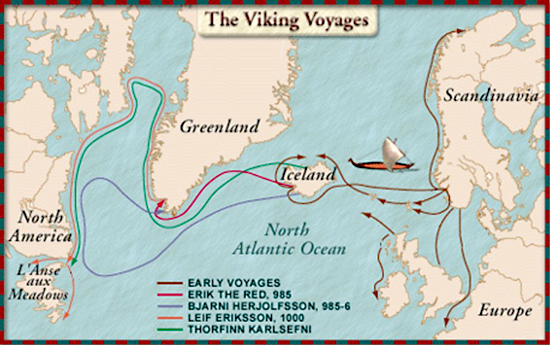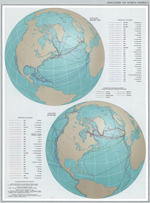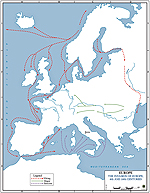|

 Explorers, Scientists &
Inventors
Explorers, Scientists &
Inventors
 Musicians, Painters &
Artists
Musicians, Painters &
Artists
 Poets, Writers &
Philosophers
Poets, Writers &
Philosophers
 Native Americans & The Wild
West
Native Americans & The Wild
West
 First Ladies
First Ladies
 Popes
Popes
 Troublemakers
Troublemakers
 Historians
Historians
 Archaeologists
Archaeologists
 Royal
Families
Royal
Families
Assassinations in History
Who
got slain, almost slain, when, how,
why, and by whom?
 Go to the
Assassination Archive
Go to the
Assassination Archive

Online History Dictionary A - Z



Voyages in History
When did what
vessel arrive with whom onboard and where
did it sink if it didn't?
 Go to the
Passage-Chart
Go to the
Passage-Chart

|
|

Map of the Viking Voyages
Smithsonian National Museum of
Natural History
The Vikings
Originating from Scandinavia (Norway,
Sweden, Denmark), the Vikings are also called the
 Norsemen.
Norsemen.
|
|
When Did the Vikings
Live?
The Vikings' heyday was roughly from the
8th to the 11th century. England in particular was targeted for
invasion and colonization from 875-950.
Image Above
Viking Voyages, Map, Smithsonian,
illustrating:
Early Voyages, the voyages of
Erik the Red
- 985
Bjarni Herjolfsson - 985-986
Leif Eriksson - 1000
Thorfinn Karlsefni
What Does the Word
Viking Mean?
Back in the days and feared for their pillaging sprees, these tough
warriors were simply called The Danes.
Starting in the early 1800s, a word from
the Old Norse language, vikingr, was revived.
In detail:
The word vikingr stems from the Old Norse word vik,
which means creek or inlet. Hence, the word vikingr
is translated as one who came from the fjords.
When someone used the word Viking
back in the days, they usually referred to a person from the Vik,
which was the name of today's Skagerrak, the huge bay between
Norway, Sweden, and Denmark.
|
What Language Did the
Vikings Speak?
The language of the Vikings is called Viking Norse, which in turn is
a phase of the Old Norse. Viking Norse was written and spoken from
700-1100; Old Norse altogether was in use from AD 100 - 1500.
What Influence Did the
Vikings Have?
The
Vikings were busy raiding all their way down to Spain and the
Mediterranean coast.
In 881, the Vikings suffered a rare
defeat at the Battle of Saucourt. Happy winner of the day was
 Louis III.
Louis III.
In 886,
 Charles III the
Fat had to pay the Vikings in order to save Paris from a
Scandinavian pillaging fest.
Charles III the
Fat had to pay the Vikings in order to save Paris from a
Scandinavian pillaging fest.
Did the Vikings Wear
Helmets with Horns?
No. Not in battle, not at home, not to the
office. The only proper occasion to wear a horned helmet was a
ceremonial procession.
When Did the Vikings
Discover America?
Leif Eriksson,
also spelled Leif Ericsson, was
one of the first European explorers who came to North America.
Leif Eriksson
lived approx. 970-1020. He arrived in North America (exact location
not known) around the year 1000 and called his new discovery
Vinland.

985 -
1794 Discovery of North America
L’Anse aux Meadows is a National Historic Site in
Newfoundland, Canada. The site features the remains of an
11th-century Viking settlement. It is the only authenticated site of
Norse settlement known in North America.

Map Location of L’Anse aux Meadows
And here are more maps on the Vikings. Click on map to enlarge.

8-10th Century Europe:
Invasions

150-1066
Germanic Migrations

History Channel's
Clever Miss March AD 796 Ad in Playboy's March 2014 Issue
More History
|